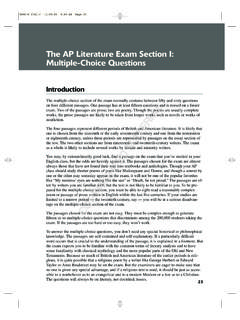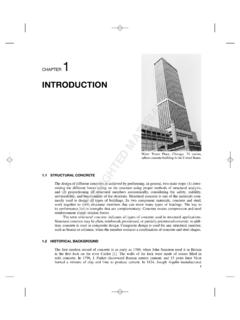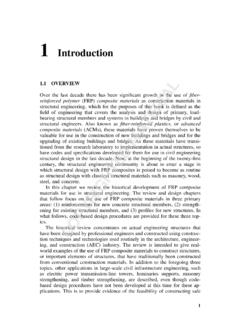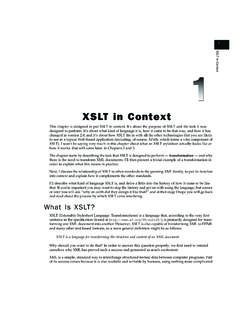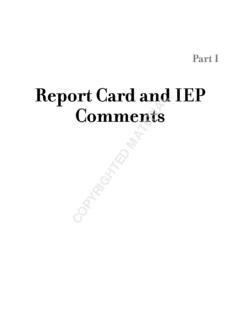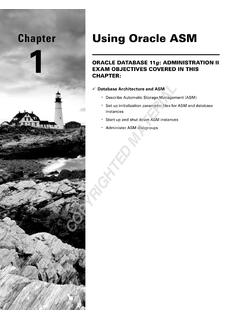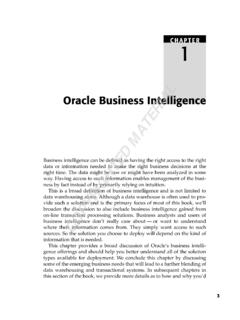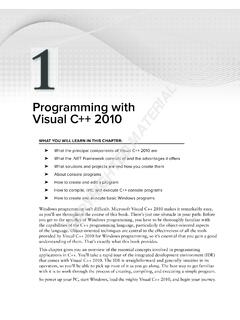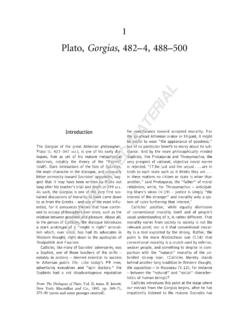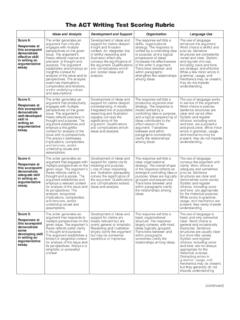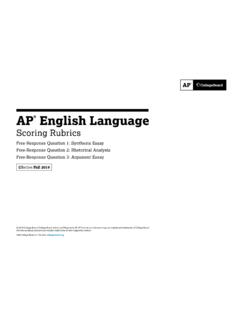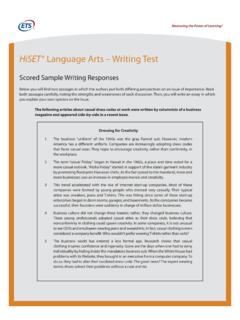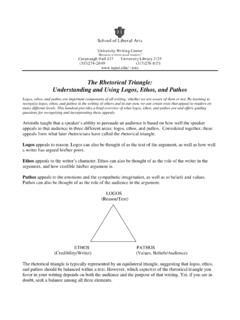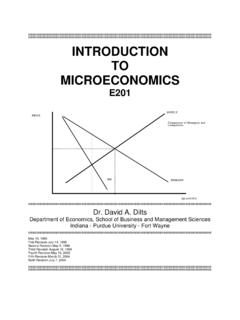Transcription of The AP Literature Exam Section I: Multiple-Choice Questions
1 23 The AP Literature Exam Section I: Multiple-Choice QuestionsIntroductionThe Multiple-Choice Section of the exam normally contains between fifty and sixty questionson four different passages. One passage has at least fifteen Questions and is reused on a futureexam. Two of the passages are prose; two are poetry. Though the poems are usually completeworks, the prose passages are likely to be taken from longer works such as novels or works four passages represent different periods of British and American Literature . It is likely thatone is chosen from the sixteenth or the early seventeenth century and one from the restorationor eighteenth century, unless these periods are represented by passages on the essay Section ofthe test. The two other sections are from nineteenth- and twentieth-century writers. The examas a whole is likely to include several works by female and minority may, by extraordinarily good luck, find a passage on the exam that you ve studied in yourEnglish class, but the odds are heavily against it.
2 The passages chosen for the exam are almostalways those that have not found their way into textbooks and anthologies. Though your APclass should study shorter poems of poets like Shakespeare and Donne, and though a sonnet byone or the other may someday appear on the exam, it will not be one of the popular favoriteslike My mistress eyes are nothing like the sun or Death, be not proud. The passages are of-ten by writers you are familiar with, but the text is not likely to be familiar to you. To be pre-pared for the Multiple-Choice Section , you must be able to sight-read a reasonably complexpoem or passage of prose written in English within the last five centuries. If your studies arelimited to a narrow period the twentieth century, say you will be at a serious disadvan-tage on the Multiple-Choice Section of the passages chosen for the exam are not easy.
3 They must be complex enough to generate fifteen or so Multiple-Choice Questions that discriminate among the 200,000 students taking theexam. If the passages are too hard or too easy, they won t answer the Multiple-Choice Questions , you don t need any special historical or philosophicalknowledge. The passages are self-contained and self-explanatory. If a particularly difficultword occurs that is crucial to the understanding of the passage, it is explained in a footnote. Butthe exam expects you to be familiar with the common terms of literary analysis and to havesome familiarity with classical mythology and the more popular parts of the Old and NewTestaments. Because so much of British and American Literature of the earlier periods is reli-gious, it is quite possible that a religious poem by a writer like George Herbert or EdwardTaylor or Anne Bradstreet may be on the exam.
4 But the examiners are eager to make sure thatno one is given any special advantage, and if a religious text is used, it should be just as acces-sible to a nonbeliever as to an evangelical and to a modern Moslem or a Jew as to a Questions will always be on literary, not doctrinal, 11/29/00 9:40 AM Page 23 COPYRIGHTED MATERIALBe glad if you have a teacher who insists on spending weeks on seventeenth- or eighteenth-century works when you would rather be talking about Vonnegut or Stoppard. Unless you recomfortable with the unfamiliar vocabulary, syntax, and conventions of the Literature writtenbefore our time, you ll have trouble with the Multiple-Choice Section of the exam and possiblywith two-thirds of the essay Section as it will be helpful if you practice Multiple-Choice exams before you take the exam inMay, your first task is to learn to analyze a poem and a prose passage.
5 To practice your skills,you ll find the best exams are those published by the Advanced Placement Program of theCollege Board. The Multiple-Choice Section of some past Literature exams are available and canbe ordered. Though several commercially published AP study guides contain sample Multiple-Choice exams, their Questions and choice of texts are often not sufficiently like those on the realexams to make them very useful. (The exams in this book, it goes without saying, are an excep-tion to this rule.)There is no quick and easy way to master the analysis of Literature . If there were, you wouldn tneed to spend four years in high-school English classes, and English teachers would be sellingreal estate or practicing law or be out of a job. The Advanced Placement Literature exam is test-ing all that you ve learned about reading and writing English in junior and senior high you can develop a method for approaching the literary texts you ll be asked to read on theAP PoemsSome students have trouble with sight-reading poetry because they don t know where to see the word death in the first line and tomb in the third and jump to the conclusionthat this poem (which, in fact, is a sentimental lover s pitch to a woman who has turned himdown) must be about mortality, and then spend the next ten minutes trying to make the poem fitthese gloomy avoid premature conclusions, and to prepare yourself for the kind of Questions the Multiple-Choice Section asks, try going through each poem asking the following Questions in somethinglike this What is the dramatic situation?
6 That is, who is the speaker (or who are the speakers)? Is the speaker a male or female?Where is he or she? When does this poem take place? What are the circumstances?Sometimes you ll be able to answer all the Questions : The speaker is a male psychopathliving in a remote cottage, probably in Renaissance Italy, who has strangled his mistressand is sitting with her head propped upon his shoulder (Browning s Porphyria s Lover ).Sometimes you ll be able to answer only a few, and sometimes only vaguely: The speakeris unnamed and unplaced and is speaking to an indeterminate audience. No you ve begun to understand the II: Analysis of Exam Areas8686-6 11/29/00 9:40 AM Page 242. What is the structure of the poem?That is, what are the parts of the poem and how are they related to each other? What givesthe poem its coherence? What are the structural divisions of the poem?
7 In analyzing the structure, your best aid is the punctuation. Look first for the completesentences indicated by periods, semicolons, question marks, or exclamation ask how the poem gets from the first sentence to the second and from the secondto the third. Are there repetitions such as parallel syntax or the use of one simile in eachsentence? Answer these Questions in accordance with the sense of the poem, not bywhere a line ends or a rhyme falls. Don t assume that all sonnets will break into an 8 6 ora 4 4 4 2 pattern, but be able to recognize these patterns if they are about the logic of the poem. Does it, say, ask Questions , then answer them? Or de-velop an argument? Or use a series of analogies to prove a point? Understanding the struc-ture isn t just a matter of mechanics. It will help you to understand the meaning of thepoem as a whole and to perceive some of the art, the formal skills that the poet has What is the theme of the poem?
8 You should now be able to see the point of the poem. Sometimes a poem simply says Ilove you; sometimes the theme or the meaning is much more complex. If possible, definewhat the poem says and why. A love poem usually praises the loved one in the hope thatthe speaker s love will be returned. But many poems have meanings too complex to be re-duced to single sentences. When this is true, a good Multiple-Choice writer won t ask for asingle theme or Are the grammar and meaning clear?Make sure you understand the meaning of all the words in the poem, especially words youthought you knew but which don t seem to fit in the context of the poem. Also make sureyou understand the grammar of the poem. The word order of poetry is often skewed, andin a poem a direct object may come before the subject and the verb. ( His sounding lyrethe poet struck can mean a poet was hit by a musical instrument, but as a line of poetry, itprobably means the poet played his harp.)
9 5. What are the important images and figures of speech?What are the important literal sensory objects, the images, such as a field of poppies or astench of corruption? What are the similes and metaphors of the poem? In each, exactlywhat is compared to what? Is there a pattern in the images, such as a series of compar-isons all using men compared to wild animals? The most difficult challenge of reading po-etry is discriminating between the figurative ( I love a rose that is, my love is like arose, beautiful, sweet, fragile) and the literal ( I love a rose that is, roses are my fa-vorite flower). Every exam tests a reader s understanding of figurative language manytimes in both the Multiple-Choice and essay What are the most important single words used in the poem?This is another way of asking about diction. Some of the most significant words in a poemaren t figurative or images but still determine the effect of the poem.
10 A good reader recog-nizes which words usually nouns and verbs, adjectives and adverbs are the keys tothe AP Literature Exam Section 1: Multiple-Choice Questions8686-6 11/29/00 9:40 AM Page 257. What is the tone of the poem?Tone is a slippery word, and almost everyone has trouble with it. It s sometimes used tomean the mood or atmosphere of a work, though purists are offended by this definition. Orit can mean a manner of speaking, a tone of voice, as in The disappointed coach s tonewas sardonic. But its most common use as a term of literary analysis is to denote the in-ferred attitude of an author. When the author s attitude is different from that of thespeaker, as is usually the case in ironic works, the tone of voice of the speaker, which maybe calm, businesslike, even gracious, may be very different from the satiric tone of thework, which reflects the author s disapproval of the speaker.
